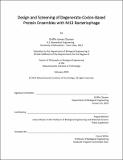| dc.contributor.advisor | Angela Belcher. | en_US |
| dc.contributor.author | Clausen, Griffin James. | en_US |
| dc.contributor.other | Massachusetts Institute of Technology. Department of Biological Engineering. | en_US |
| dc.date.accessioned | 2019-07-15T20:35:46Z | |
| dc.date.available | 2019-07-15T20:35:46Z | |
| dc.date.copyright | 2019 | en_US |
| dc.date.issued | 2019 | en_US |
| dc.identifier.uri | https://hdl.handle.net/1721.1/121700 | |
| dc.description | This electronic version was submitted by the student author. The certified thesis is available in the Institute Archives and Special Collections. | en_US |
| dc.description | Thesis: Ph. D., Massachusetts Institute of Technology, Department of Biological Engineering, 2019 | en_US |
| dc.description | Cataloged from student-submitted PDF version of thesis. | en_US |
| dc.description | Includes bibliographical references. | en_US |
| dc.description.abstract | A billion years of evolution has crafted a diverse set of proteins capable of complex and varied functionalities. Within recent decades, scientists have applied both rational design and directed evolution to accelerate development of high-value proteins, including biotherapeutics. While computational modelling increasingly facilitates protein design, empirically screening large collections of protein variants remains an essential component of protein engineering. This process requires generating protein variation, partitioning variants with a selection pressure, and identifying highly functional proteins. This thesis presents computational tools for initial protein library design, leverages high-throughput sequencing for phage display screenings, and reports biotemplating of an inorganic phase-change material onto the filamentous M13 phage surface. | en_US |
| dc.description.abstract | Designing ensembles of protein variants involves optimizing library size and quality with constraints on screening capacity, cost, and experimental complexity. Incorporating degenerate codons during oligonucleotide synthesis enables residue-specific protein randomization with a known amino acid scope. However, this widely adopted method often generates uneven variant abundances that diverge exponentially with additional randomized residues. The first section of this work presents tools for the design and assessment of degenerate-codon-based protein libraries. This framework facilitates incorporating an arbitrarily large number of randomized sites, non-standard genetic codes, and non-equimolar nucleotide mixtures. In addition to library size and coverage calculations, whole-population diversity metrics and abundance quantiles are reported. | en_US |
| dc.description.abstract | An evolutionary solver to optimize non-equimolar base compositions to match amino acid profiles, as well as mutational profiling for spike-in oligonucleotides is also presented. The second section of this thesis develops an experimental and data analysis pipeline for integrating high-throughput DNA sequencing with M13 phage display biopanning. Deeply sequencing naïve M13 peptide libraries elucidated censorship patterns for both p3 and p8 coat protein fusions. Streptavidin panning recapitulated the HPQ binding motif after a single panning round, and additional biopannings pursued M13 p8 variants that interact with both gold films and carbon nanotubes. Furthermore, this thesis explores the effect of M13 p8 surface charge on the biotemplating of an inorganic phase-change material. An ambient temperature synthesis for modulating the atomic composition of germanium-tin-oxide nanomaterials is reported. | en_US |
| dc.description.statementofresponsibility | by Griffin James Clausen. | en_US |
| dc.format.extent | 161 pages | en_US |
| dc.language.iso | eng | en_US |
| dc.publisher | Massachusetts Institute of Technology | en_US |
| dc.rights | MIT theses are protected by copyright. They may be viewed, downloaded, or printed from this source but further reproduction or distribution in any format is prohibited without written permission. | en_US |
| dc.rights.uri | http://dspace.mit.edu/handle/1721.1/7582 | en_US |
| dc.subject | Biological Engineering. | en_US |
| dc.title | Design and screening of degenerate-codon-based protein ensembles with M13 bacteriophage | en_US |
| dc.type | Thesis | en_US |
| dc.description.degree | Ph. D. | en_US |
| dc.contributor.department | Massachusetts Institute of Technology. Department of Biological Engineering | en_US |
| dc.identifier.oclc | 1102635023 | en_US |
| dc.description.collection | Ph.D. Massachusetts Institute of Technology, Department of Biological Engineering | en_US |
| dspace.imported | 2019-07-15T20:35:44Z | en_US |
| mit.thesis.degree | Doctoral | en_US |
| mit.thesis.department | BioEng | en_US |
